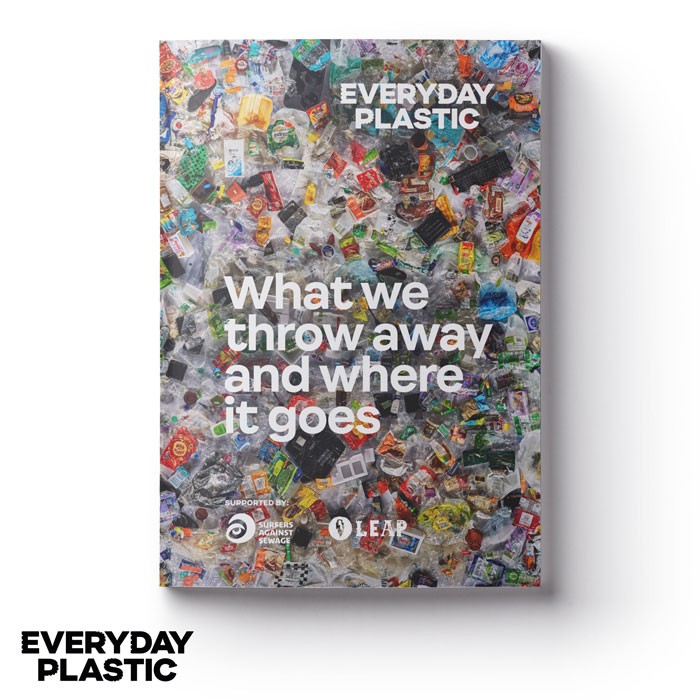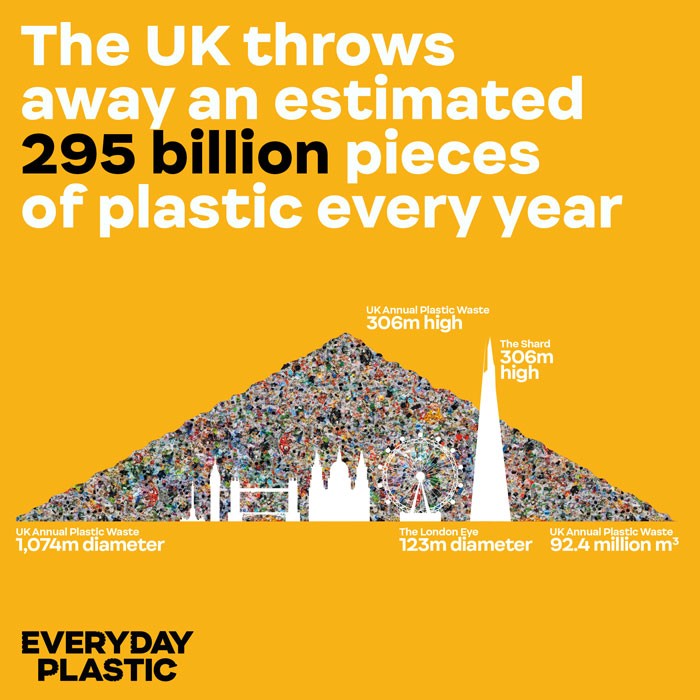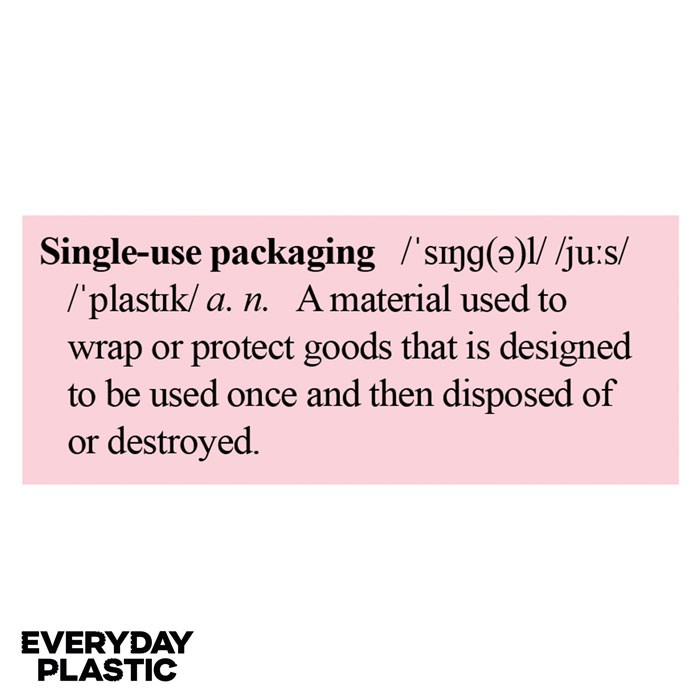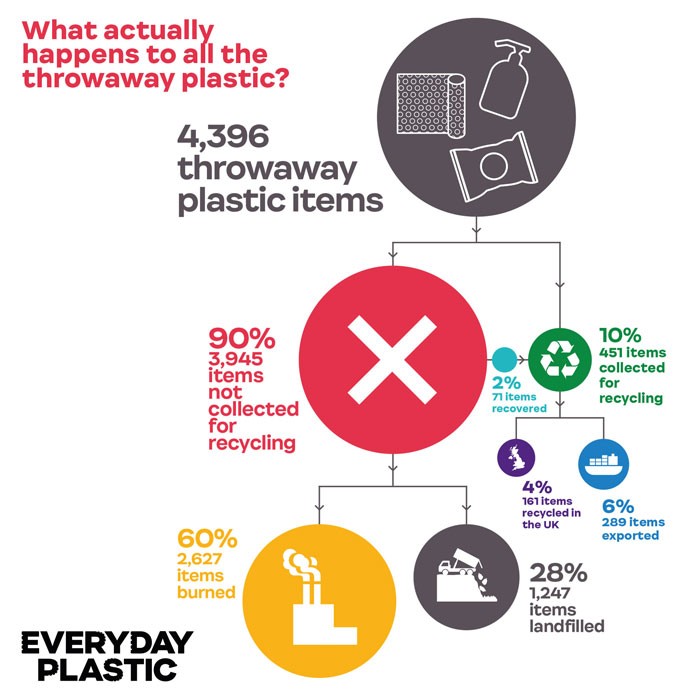Back in June we launched our documentary Materials: Living with plastic, in which we spoke to Daniel Webb, founder of Everyday Plastic. At that stage, the research-led initiative was 18-months in, with Daniel having collected every piece of plastic he used throughout 2017; a decision he made following a litter strewn jog on the beach of his hometown, Margate. We joined him and fellow researcher Dr Julie Schneider as they began the long and intensive process of collating, weighing, cataloging and photographing the rare anthropological collection.
It was the beginnings of an unprecedented and unprompted attempt to discover the average individual’s plastic consumption across the course of a year. The project has gained national exposure, with Daniel being invited to share his story on Sky News, BBC Radio 4 and at festivals including Bestival and WOMAD. Indeed, the realisation that we have unwittingly become completely dependent upon plastics has begun to precipitate through society via a regular drip feed in the mainstream media. The term ‘single-use’ was even granted the Collins Dictionary’s double-edged status of Word of the Year, having been used so copiously when underlining one of the key issues surrounding our over consumption of the material.
Everyday Plastic has no doubt influenced this newfound consciousness, but for Dan, there is still a lot more to be done, not least with the eye opening and stomach churning findings outlined in the report he has co-authored with Dr Schneider, What we throw away and where it goes.
I caught up with him to find out more about the report and how we can all help to form the Everyday Plastic charity, which Dan hopes can raise further awareness and encourage positive action, without the endless guilt.
JB: What we throw away and where it goes is both a fascinating and disturbing read, perhaps we should start with that poignant image you have created that depicts a pile of rubbish as tall as the Shard?
DW: Yes, there are some interesting infographics throughout the report but that is perhaps the scariest. What it shows, is that by applying the volume of plastic I collected as an individual to the entire UK population, we would create a pile of plastic that would rise as high as the Shard – some 306m – and its base would have a diameter of over a kilometre. In terms of weight, that pile would add up to a staggering 2.3 million tonnes worth – the equivalent of about half of the UK population itself.
JB: It’s an incredible image to get your head around, but there are so many shocking finds, not least the sheer volume of your plastic that was deemed as ‘single-use’ – the type of plastic that we are all now hyper-aware and fearful of!
DW: Exactly, 93% was specifically single-use packaging such as salad bags or toothpaste tubes, which we define as ‘a material used to wrap or protect goods that is designed to be used once and then disposed of or destroyed’. Collecting my plastic waste for a year certainly says a lot about me, but it also says a lot about us, and I wanted this experiment to be representative of everyone. So imagine that 93% of that Shard-high pile of plastic is single-use plastic packaging, over two-thirds of which is used to wrap and pack food.
JB: But things get really dark when you dig deeper when it comes to recycling – something that we’ve all generally been taught to do for decades. The report has some hard-hitting and challenging things to say about plastic recycling doesn’t it?
DW: We’re not being told the truth about recycling. The gap between our expectations and reality is huge. For instance, we calculated that 70% of my plastic is currently not recyclable. Now that’s one problem. But of the 30% that is recyclable, only 10% of it would be collected here in the UK. There are over 400 local authorities in England alone, all of which have their own waste collection and management systems. We simply don’t know what we can put in the recycling bin, and we know even less about what happens when it’s collected. It turns out that more of the plastic waste that goes into the recycling bin is exported overseas for other countries to deal with. Government and industry define this exporting as ‘recycling’. Only 4% of the recyclable plastic I generated actually gets recycled here in the UK. This number says a lot about the huge limitations of our current recycling system, but also that we are just producing too much.
JB: And so, the plastic that we do use, which we all hope might have been made from plastic now in its umpteenth incarnation is actually virgin plastic – made entirely of newly-made plastic?
DW: Of the 4,490 piece of plastic that I collected over a year, only 59 were made of recycled materials – that’s only 1.3%. Now that might seem odd as I just said that 4% of my waste would have been recycled; you’d expect to see all of these materials return to the shelves. Unfortunately, the image of recycling that has been constructed is very inaccurate. When we think of recycling, we naturally imagine say, a bottle, being recycled into a new bottle in an infinite loop. Circular economies such as this are certainly what we should strive for, but in reality there is unavoidable loss during the plastic recycling process. Don’t forget that it’s also very hard to extract pure plastics, as there is normally some form of contamination via other plastics, food or chemicals. This is currently a major factor as only a very small percentage of recycled plastics meeting the quality standards that packaging companies demand.
JB: So what is the answer Dan? Is the plastic problem in any way answerable – have you found positives through the process and ones that we can all take heed from?
DW: I don’t think there’s any one answer to this – that’s been proven by recycling, which is not and never will be the sole solution. That doesn’t mean to say that we should give up on it. We should all continue to push for greater recycling infrastructure here in the UK. But from my experience I have come to realise that the plastic problem is a by-product of consumerism, and we can all pay more attention to how we individually consume. The stats and figures don’t lie and we can apply them in a positive way – if I’d have completely given up plastic water bottles, straws, stirrers, cutlery bags and shower gel I would have thrown away 316 less pieces of plastic. Apply that to the UK population, in fact even only half of it, and we could collectively prevent 10 billion pieces from entering the waste stream.
JB: Ah, a more positive sounding shard of hope in all of this! And having self-funded and self-motivated the project to date there is further hope on the horizon in the form of the Everyday Plastic charity?
DW: Hopefully! There is about a week left of a Kickstarter campaign that if we hit the target, can really help in setting up the charity. The aim of the charity will be to extend our research and create all-important educational programmes that can help things move forward. It’s so important that we all continue to raise awareness and encourage positive action, particularly so that government officials and corporations hear. The hope is that charity can offer a platform for us everyday folk to relate to these enormous issues on a personal level. And I genuinely believe that if we are given honest and true information, then people can inspire that positive change.
As the name of Dan’s project shows, much of the problem with plastic lies in its everyday nature. Plastic has become the most ubiquitous of all materials and one that we had grown almost entirely blind to. With it, we have all implicitly become part of the problem. But we can all take steps towards reducing the amount of plastic we consume, which in turn drives down the need to produce more. They might be small steps, but collectively, we can take many, together.
For more information about The Everyday Plastic Charity visit the Kickstarter page.
To keep informed about Everyday Plastic and to get in touch with Dan visit the website.





![2.-Confectionery-[Credit-line]-Photo_-©-Ollie-Harrop-2018.-Image-courtesy-of-Everyday-Plastic-web](https://www.designinsiderlive.com/wp-content/uploads/2018/12/2.-Confectionery-Credit-line-Photo_-©-Ollie-Harrop-2018.-Image-courtesy-of-Everyday-Plastic-web-700x515.jpg)




![7.-Plastic-bags-[Credit-line]-Photo_-©-Ollie-Harrop-2018.-Image-courtesy-of-Everyday-Plastic-web](https://www.designinsiderlive.com/wp-content/uploads/2018/12/7.-Plastic-bags-Credit-line-Photo_-©-Ollie-Harrop-2018.-Image-courtesy-of-Everyday-Plastic-web-700x606.jpg)